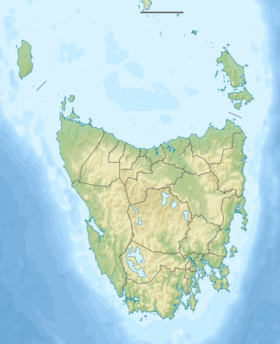Huon Valley
| Huon | |
| Valley | |
| Huon River in summer, located on the valley floor. | |
| Name origin: Jean-Michel Huon de Kermadec | |
| Nickname: The Huon | |
| Country | Australia |
|---|---|
| State | Tasmania |
| Region | Southern Tasmania |
| Local government area | Huon Valley Council |
| City | Huonville, Southport |
| River | Huon River |
| Coordinates | 43°07′S 146°26′E / 43.12°S 146.43°ECoordinates: 43°07′S 146°26′E / 43.12°S 146.43°E |
| Area | 5,500 km2 (2,124 sq mi) |
 Location of the Huon Valley in Tasmania | |
The Huon Valley, or simply the Huon[1] is a valley and geographic area located in southern Tasmania, Australia. It roughly corresponds to the Huon Valley Council local government area, yet predates that entity. The largest town is Huonville, with other smaller towns spread across the area. It includes Australia's most southern permanent settlement at Southport. The Huon Valley Council area had a population of 15,140 in 2011.[2] Famed for its apple growing, the Valley was first settled by British colonists in the 1840s;[3] prior to settlement the Huon Valley area was inhabited by the Nuenonne people.[4]
The area it is sometimes combined as the Huon-Channel area with the areas around D'Entrecasteaux Channel.[1]
Etymology
The Huon Valley, along with its local government authority, several towns, the Huon River and the Huon Pine were named after Jean-Michel Huon de Kermadec.[5]
Economy
The Huon is both a major horticultural area, particularly famous for growing apples (83% of Tasmanian apples originate in the Valley),[6] but also producing cherries, berries and stone fruit and is home to many commuter workers who work in Hobart or Kingston and prefer to live in a more rural setting.[7] It is also a major source of seafood; the Valley hosts the headquarters of Huon Aquaculture and the major processing plants for Tassal.[8] The largest employers are agriculture, forestry and aquaculture, followed by out of Valley work;[9] Tourism is a growing industry in the Huon Valley, and the valley attracts around 25% of Tasmania's tourist visitors.[10]
History
The area was first settled in the early 1840s. In 1843 Thomas Judd planted the first apple trees, founding the industry that made the Huon famous. He was followed by Silas Parsons, founder of Grove and then Wm. Barnett, Wm. Cuthbert and then William Geeves, namesake of Geeveston.[3]
Government
The valley falls entirety into the Commonwealth Division of Franklin and the Tasmanian House of Assembly State Division of Franklin.[11] The Huon Valley Council in the local government authority. It was previously divided among the Municipalities of Port Cygnet, Espererance and Huon, which merged in 1993 to form the Huon Valley Council.[12]
In 2016 the Huon Valley Council was sacked by the state government after a long period of severe dysfunction.[13]
Media
The Huon Valley hosts the Huon News, a weekly local newspaper, and the Cygnet & Channel Classifieds, a small local newsletter. Geeveston is the headquarters of Huon FM, a community radio station. It was historically served by the Huon Times, which closed in 1942. The Huon Valley also has local community radio station Pulse FM Kingborough and Huon.
See also
References
- 1 2 Brooks, comp. by Maureen; Centre, Joan Ritchie at the Australian National Dictionary (1995). Oxford Tassie terms : a glossary of Tasmanian words. Melbourne [u.a.]: Oxford Univ. Pr. ISBN 0195538129.
- ↑ "2011 Census QuickStats - Huon Valley (M)". censusdata.abs.gov.au. Australian Bureau of Statistics. Retrieved 5 December 2015.
- 1 2 "THE WONDERFUL HUON.". The Mercury (Hobart, Tas. : 1860 - 1954). Hobart, Tas.: National Library of Australia. 12 March 1930. p. 8. Retrieved 23 March 2015.
- ↑ "Heritage of the Huon Valley" (PDF). huonvalley.tas.gov.a. Huon Valley Council. Retrieved 5 December 2015.
- ↑ "Huon". electoral.tas.gov.au. Electoral Council of Tasmania. Retrieved 23 March 2015.
- ↑ "Fruit Growers Tasmania - INDUSTRY INFORMATION". fruitgrowerstas.com.au. Fruit Growers Tasmania Inc. Retrieved 5 December 2015.
- ↑ Landis, edited by Wayne G. (2005). Regional scale ecological risk assessment using the relative risk model. Boca Raton: CRC Press. p. 161. ISBN 9780203498354. Retrieved 23 March 2015.
- ↑ "How Huon Aquaculture netted a fortune from salmon". Financial Review. 17 October 2014. Retrieved 23 March 2015.
- ↑ "huonvalley.tas.gov.au" (PDF). huonvalley.tas.gov.au. Huon Valley Council. Retrieved 5 December 2015.
- ↑ "Huon Valley Regional Tourism Strategy 2009 – 2012" (PDF). huonvalley.tas.gov.au. Huon Valley Council. Retrieved 5 December 2015.
- ↑ "TASMANIAN HOUSE OF ASSEMBLY DIVISIONS" (PDF). Electoral Commission of Tasmania. Electoral Commission of Tasmania. Retrieved 27 March 2015.
- ↑ "ESPERANCE MUNICIPAL COUNCIL". archives.tas.gov.au. Archives Tasmania. Retrieved 27 March 2015.
- ↑ http://www.themercury.com.au/news/politics/local-government-minister-peter-gutwein-announces-dismissal-of-huon-valley-council/news-story/cebcac3c74b0cd2b1082464b1aed2172